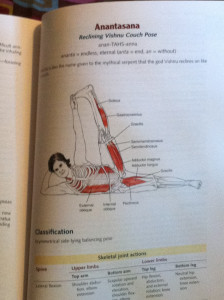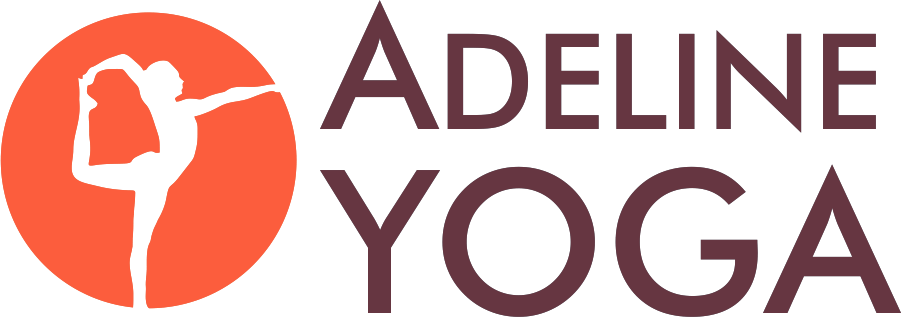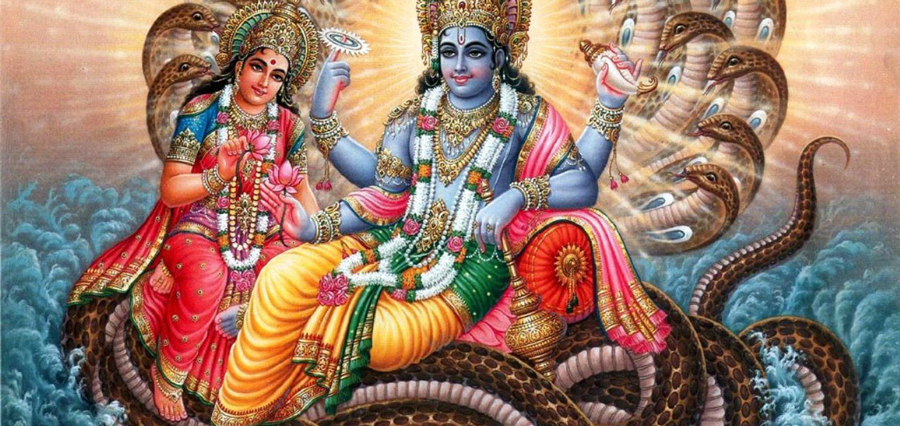In a recent class with Heather we opened our chests, shoulders and minds about the serpent god, Ananta. We started simply enough in Child’s pose with arms stretched out ahead of us. Next, as we lay down across a blanket for a mild upper back bend, I thought to myself, “I’m so glad this is going to be an easy, rejuvenating class.”
Up in tadasana and then into adho mukha savasana to open, strengthen and rotate shoulders and arms straight out with hands, wrists and fingers flat on the floor. “OK, we’re warming up now,” I thought, right before we laid back on the floor for a series of active chest openers and passive backbends that worked the sides and opened the shoulders, culminating in Anantasana or Reclining Vishnu Couch Pose.
According to Yoga Anatomy, by Kaminoff and Matthews, Anantasana is an asymmetrical side-lying balance. You bet it is. I worked every ab and back muscle to keep a straight line on my mat just balancing on my sides with head relaxed on my upper arm. Then, head up on one elbow sounded easy enough, but no. The armpit was 1-2 inches from the floor, my elbow pointed out in front of me, and why is my neck so tight?!
Now we’re supposed to lift one leg, grabbing the big toe while keeping everything else straight and balanced on our mats.
In Kaminoff and Matthews’ notes, it cautions rolling over backwards if you’re not using the abductors and hip flexors to lift the leg. Well, that was me flopping over backwards and forwards trying to lift and balance. Although I didn’t have the bandwidth to look around, I suspect I wasn’t the only one flopping around like a fish!
While I struggled with this balancing act, Heather read about Ananta from Light on Yoga. Ananta is the name of Visnu and also of Visnu’s couch, the Serpent Sesa. We are getting longer and more lithe as we extend our spines still balancing on our sides on the floor.
According to Hindu mythology, Vishnu sleeps in the primeval ocean on the thousand-headed serpent couch, Sesa. The story goes that Lord Vishnu was watching Lord Siva’s Cosmic Dance when he began to move with the rhythm and awaken the serpent Sesa. With all the excitement of the dance, Sesa seeks out reincarnation in human form to study and enjoy the dance. The story continues that the human boy reincarnates in South India as Patanjali, the author of three treatises including Yoga Sutras, a compilation of yoga teachings.
 Wow. That’s fantastic!
Wow. That’s fantastic!
Even more fantastic is the feeling of openness and stability in the shoulders after our serpentine movements on the yoga mat.
The mix of Child’s pose, a mild backbend, supta padagustasana and variations, plus the beginnings of Pincha Mayurasana led us to the benefits of more shoulder strengthening. That’s when I realize this easy class has drained me of every ounce of energy, yet I’m oddly invigorated.
With the mix of unfamiliar postures and mysterious cosmic stories, my body is rejuvenated and exhausted, and my mind ponders the reincarnation of the Sesa serpent god into the supreme yoga compiler and transcriber, Patanjali.
Namaste,
— Ruth Rooney, Adeline Yoga Student


iYogaprops | Yoga Ropes says
What’s really great about Anantasana is that you can do it comfortably at home when you finally learn its proper poses. It’s a really great practice for people who want that tight, flat stomach or really strong abs. This was a great read!